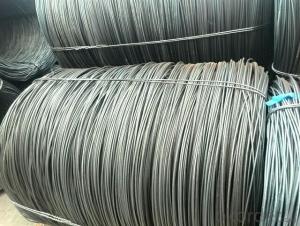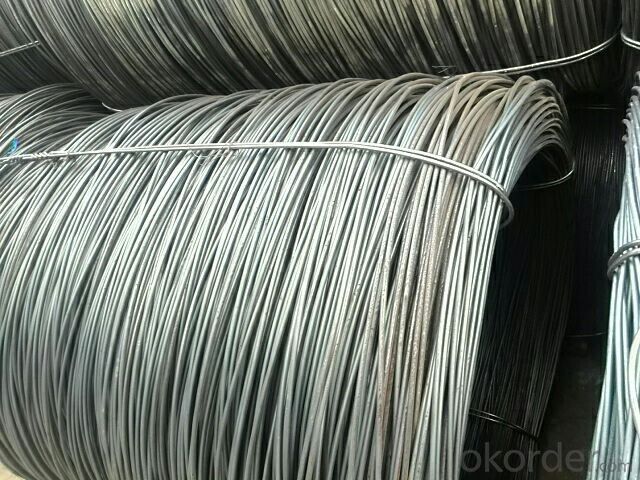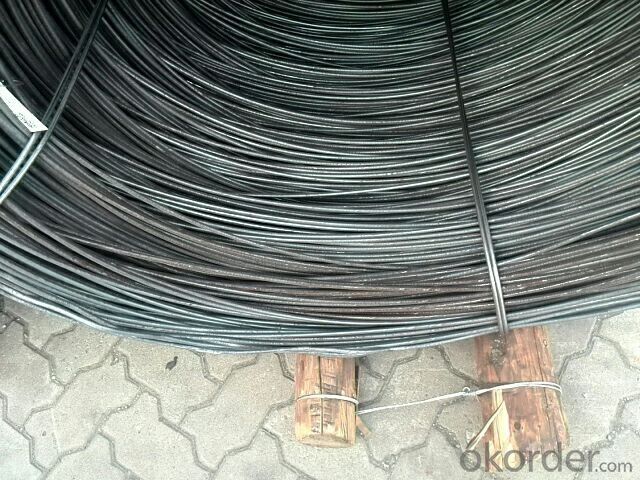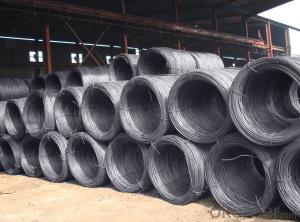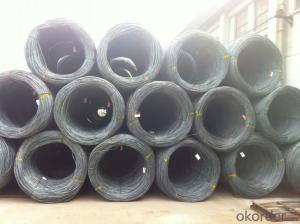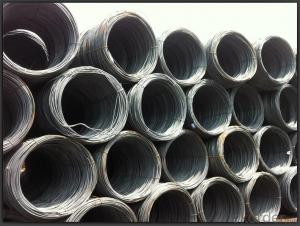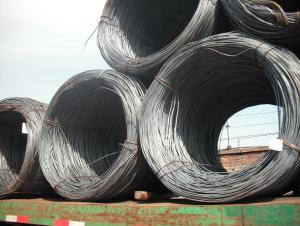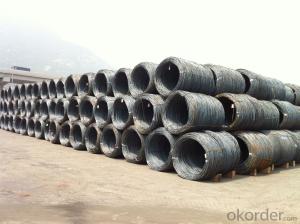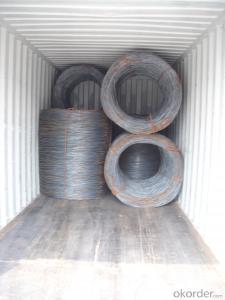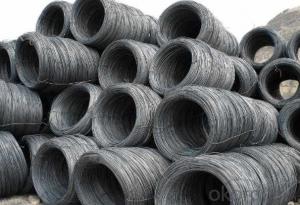Wire Rod Sae1008 With High Quality
- Loading Port:
- China Main Port
- Payment Terms:
- TT or LC
- Min Order Qty:
- -
- Supply Capability:
- -
OKorder Service Pledge
OKorder Financial Service
You Might Also Like
Product Description:
OKorder is offering Wire Rod SAE1008 WITH HIGH QUALITY at great prices with worldwide shipping. Our supplier is a world-class manufacturer of steel, with our products utilized the world over. OKorder annually supplies products to European, North American and Asian markets. We provide quotations within 24 hours of receiving an inquiry and guarantee competitive prices.
Product Applications:
Wire Rod SAE1008 WITH HIGH QUALITY are ideal for structural applications and are widely used in the construction of buildings and bridges, and the manufacturing, petrochemical, and transportation industries.
Product Advantages:
OKorder's Wire Rod SAE1008 WITH HIGH QUALITY durable, strong, and resist corrosion.
Main Product Features:
· Premium quality
· Prompt delivery & seaworthy packing (30 days after receiving deposit)
· Corrosion resistance
· Can be recycled and reused
· Mill test certification
· Professional Service
· Competitive pricing
Product Specifications:
Steel Grade: SAE1008B Standard: ASTM, GB
Diameter: 5.5mm, 6.5mm, 7mm,8mm,9mm,10mm,12mm,14mm
Type: Drawn Wire Alloy or Not: Alloy Brand Name: N-RIVER
Technique: Hot Rolled Place of Origin: China Mainland
Chemical Composition:
Please kindly find our chemistry of our material based on SAE1008B as below for your information
Grade | Chemical Composition (%) | |||||
C | Mn | S | P | Si | B | |
SAE1008B | 0.10max | 0.32max | 0.045max | 0.040max | 0.30max | 0.0008min |
Mechanical properties | ||||||
Yield strength(N/mm2) | Tensile strength(N/mm2) | Elongation (%) | ||||
≥195 | 350-380 | ≥32 | ||||
Usage and Applications of Wire Rod SAE1008B:
After hot-rolled the products shaped into coil and delivery as finished product, including round, square, rectangular, hexagonal and so on. Since most of the products are round, it is generally called wire rod. Carbon steel wire rod is widely used in construction and manufacturing. Carbon steel wire rod is mainly used for reinforcement of reinforced concrete and welded structure or reprocessed (roberts , nail, etc.) materials, especially used to produce wire drawing, welding electrode, nails, spring, electronic, precise machinery parts and so on.
FAQ:
Q1: Why buy Materials & Equipment from OKorder.com?
A1: All products offered byOKorder.com are carefully selected from China's most reliable manufacturing enterprises. Through its ISO certifications, OKorder.com adheres to the highest standards and a commitment to supply chain safety and customer satisfaction.
Q2: How do we guarantee the quality of our products?
A2: We have established an advanced quality management system which conducts strict quality tests at every step, from raw materials to the final product. At the same time, we provide extensive follow-up service assurances as required.
Q3: How soon can we receive the product after purchase?
A3: Within three days of placing an order, we will begin production. The specific shipping date is dependent upon international and government factors, but is typically 7 to 10 workdays.
Images:

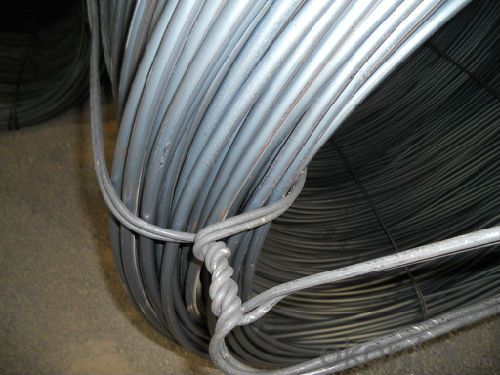
- Q: How is steel wire rod used in the manufacturing of wire rope grips?
- The strength and durability of steel wire rod make it an essential component in manufacturing wire rope grips. These grips are crucial for securely connecting wire ropes, withstanding high tension and loads. To shape the steel wire rod into the desired diameter and smoothness, it is drawn through a series of dies during the manufacturing process. This process ensures that the wire rod possesses the necessary strength and flexibility to endure the demanding conditions faced by wire rope grips. After the wire rod is drawn and shaped, it undergoes further processing to create the wire rope grips. The rod is cut to the required length and then formed into a U-shape, creating a loop that securely holds the wire rope. The ends of the wire rod are threaded to facilitate easy tightening and loosening of the grip. High-quality carbon steel is typically used to manufacture the steel wire rod used in wire rope grips. This type of steel offers excellent strength and corrosion resistance, enabling the grips to endure heavy loads and harsh environmental conditions without compromising their integrity. In conclusion, steel wire rod is employed in the manufacturing of wire rope grips to provide the necessary strength, durability, and flexibility for securing and fastening wire ropes together. The use of high-quality carbon steel ensures that these grips can withstand demanding conditions and maintain their integrity over their lifespan.
- Q: How is steel wire rod used in the manufacturing of wire rope grips?
- Steel wire rod is commonly used in the manufacturing of wire rope grips as it serves as the raw material for creating the grips. The wire rod is first drawn into the desired diameter and then undergoes a series of processes such as twisting, crimping, and shaping to form the wire rope grip. The high strength and durability of steel wire rod ensure that the resulting grip can securely hold and fasten wire ropes, making it an essential component in their production.
- Q: What are the different types of steel wire rod coatings used for abrasion resistance?
- There are several types of steel wire rod coatings used for abrasion resistance, including zinc coatings, epoxy coatings, polyurethane coatings, and ceramic coatings. These coatings help to protect the steel wire rod from wear, friction, and other forms of abrasive damage, thereby increasing its durability and lifespan.
- Q: What are the common sizes and dimensions of steel wire rod?
- The common sizes and dimensions of steel wire rods vary depending on the specific application and industry requirements. However, some commonly used sizes range from 5.5mm to 12mm in diameter, with lengths typically between 2,000mm and 3,000mm. These dimensions are commonly used in construction, manufacturing, and automotive industries, but it's important to note that there are various other sizes available to cater to specific needs.
- Q: What are the different types of steel wire rod surface cleaning equipment?
- There are several different types of steel wire rod surface cleaning equipment available in the market today. These include: 1. Shot blasting machines: Shot blasting is a popular method used to clean the surface of steel wire rods. It involves propelling small steel balls or beads at high speed onto the surface, which removes any dirt, rust, or scale. Shot blasting machines can be either airless or air-powered, and they are available in various sizes and capacities. 2. Wire brushing machines: Wire brushing machines use rotating brushes to clean the surface of steel wire rods. These brushes are made of stiff bristles, and they effectively remove dirt, rust, and scale from the surface. Wire brushing machines are available in different configurations, including hand-held tools and automated systems. 3. Ultrasonic cleaning machines: Ultrasonic cleaning is a non-abrasive method that uses high-frequency sound waves to remove contaminants from the surface of steel wire rods. The cleaning process involves immersing the rods in a tank filled with a cleaning solution, and then subjecting them to ultrasonic vibrations. This method is particularly effective in removing oil, grease, and other stubborn contaminants. 4. Chemical cleaning equipment: Chemical cleaning equipment utilizes various cleaning solutions or acids to remove dirt, rust, and scale from the surface of steel wire rods. The rods are usually dipped or sprayed with the cleaning solution, and then rinsed off with water. Chemical cleaning equipment can be manual or automated, depending on the scale of the operation. 5. Mechanical descaling machines: Mechanical descaling machines are specifically designed to remove scale from the surface of steel wire rods. These machines use rotating brushes, rollers, or abrasive belts to scrape off the scale. Mechanical descaling machines are often used in conjunction with other surface cleaning methods to achieve the desired level of cleanliness. Overall, the choice of steel wire rod surface cleaning equipment depends on factors such as the level of contamination, the desired cleanliness, and the production capacity. Each type of equipment has its own advantages and limitations, and it is crucial to select the most suitable one for the specific cleaning requirements.
- Q: How is steel wire rod used in the production of suspension cables?
- Steel wire rod is used in the production of suspension cables due to its strength and durability. Suspension cables are an essential component of bridges and other structures that require support and stability. These cables are responsible for bearing heavy loads and providing structural integrity. Steel wire rods are transformed into suspension cables through a series of manufacturing processes. The wire rods are first heated and rolled into a desired size and shape. This process strengthens the steel and aligns its grain structure, enhancing its tensile strength. Once the wire rods are formed, they are further processed to increase their resistance to corrosion. This is typically achieved through a process called galvanization, where the wire rods are coated with a layer of zinc. This protective layer helps prevent rust and corrosion, ensuring the longevity and reliability of the suspension cables. The steel wire rods are then twisted together to form strands, which are then combined to create the final suspension cable. The number of strands and the arrangement of the wires within each strand may vary depending on the specific requirements of the project. The cables are usually tensioned and anchored to the supporting structure, providing the necessary strength and stability. Overall, steel wire rods are crucial in the production of suspension cables as they offer exceptional strength, durability, and resistance to corrosion. These properties make them ideal for withstanding heavy loads and harsh environmental conditions, ensuring the safety and reliability of suspension bridges and other structures.
- Q: What are the common production processes for plutonium-coated steel wire rod?
- The common production processes for plutonium-coated steel wire rod typically involve several steps. First, the steel wire rod is cleaned and prepared to ensure its surface is free from impurities. Then, a layer of plutonium is applied onto the steel wire rod through a specialized coating process, such as physical vapor deposition or electroplating. After the plutonium coating, the wire rod may undergo further treatments, including annealing or heat treatment, to enhance its properties and durability. Finally, the coated wire rod is inspected for quality control and can be further processed or used in various applications such as nuclear fuel fabrication or research purposes.
- Q: How is steel wire rod tested for resistance to crevice corrosion?
- Steel wire rod is tested for resistance to crevice corrosion through various methods, including visual inspection, weight loss measurement, electrochemical testing, and exposure to corrosive environments. These tests help determine the susceptibility of the steel wire rod to crevice corrosion, which is crucial for ensuring its durability and performance in different applications.
- Q: What are the different types of surface defects that can occur on steel wire rod?
- There are several types of surface defects that can occur on steel wire rods, including scale, pits, scratches, cracks, and surface decarburization. These defects can affect the quality and performance of the wire rod, and they need to be carefully inspected and addressed to ensure the reliability and durability of the final product.
- Q: How is steel wire rod used in the production of tire reinforcement materials for vehicles?
- Steel wire rod is commonly used in the production of tire reinforcement materials for vehicles due to its high tensile strength and durability. The wire rod is typically formed into individual wires, which are then woven or wrapped into a mesh-like structure known as tire cord. This tire cord is embedded into the rubber compound during the tire manufacturing process, providing the necessary strength and stability to the tire. The steel wire rod ensures that the tire can withstand the forces and stresses encountered during vehicle operation, improving overall tire performance and longevity.
Send your message to us
Wire Rod Sae1008 With High Quality
- Loading Port:
- China Main Port
- Payment Terms:
- TT or LC
- Min Order Qty:
- -
- Supply Capability:
- -
OKorder Service Pledge
OKorder Financial Service
Similar products
Hot products
Hot Searches
Related keywords
